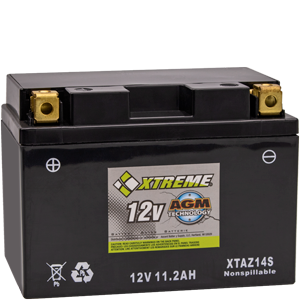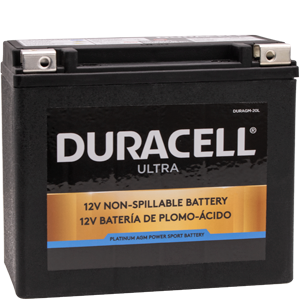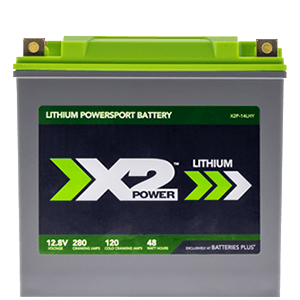Up to $15 Off Select Powersport Batteries - Buy Online & Pick Up In-Store - Ends 12/29 - See Details
Choosing the Right Motorcycle Battery
With a selection designed to meet or beat original equipment specifications for cold cranking amps (CCA), reserve capacity (RC), and amp-hour (Ah), you get the motorcycle battery you need for your next cruise on the open road.
Cold Cranking Amps
The rating that determines a battery's ability to start an engine in cold temperatures.
Reserve Capacity
How long a new fully charged battery can hold its charge.
Amp Hour
A measure of how long a battery can provide an amperage for one hour.
What Type of Motorcycle Battery Do You Need?

Flooded lead acid batteries are the most affordable motorcycle battery but tend to have shorter lifespans than AGM or lithium batteries. They also require additional maintenance.
Since flooded batteries are not completely sealed, they lose water due to evaporation when they are recharged. If you have a flooded battery, you may need to offset this water loss by periodically adding distilled or deionized water. Otherwise, the battery's plates can become corroded, shortening the battery's lifespan.
Top 4 Motorcycle Batteries

Xtreme Flooded
- 6 month warranty
- Basic Flooded
- Low Maintenance

Xtreme AGM
- 12 Month Warranty
- AGM Technology
- Maintenance Free
- Vibration Resistant

Duracell AGM
- 24 Month Warranty
- AGM Technology
- Maintenance Free
- Vibration Resistant

X2Power Lithium
- 36 Month Warranty
- Lithium Technology
- Maintenance Free
- Vibration Resistant
- Holds a Charge in Storage
Motorcycle Battery Care & Maintenance
No matter what type of battery you choose for your motorcycle, it won't work properly if it isn't maintained properly, especially during the off-season. Follow these tips to maintain and get the longest life possible out of your battery.
Keep it charged - Use a battery charger to maintain your motorcycle battery during the off-season or other long periods of inactivity.
Note: Lithium batteries have a log self-discharge rate and may require less charging maintenance during the off-season. Keep your lithium battery at around 50% when storing it for long periods of time.
Use the right charger - It's important that you select one that matches the voltage and chemistry of your motorcycle battery.
Example: 12-volt AGM charger goes with a 12-volt AGM battery.
Avoid overcharging - Overcharging your motorcycle battery can shorten its life. Prevent this by using a battery maintainer or a charger with an automatic shut-off.
Water your battery - If you have a flooded battery, periodically check and top off the electrolyte inside with distilled or deionized water.
Note: Do not attempt to do this with an AGM or lithium battery.
Keep terminals free of corrosion - Clean off corrosion on the battery terminal using a battery terminal brush and a mixture of baking soda and water. Protect the terminals with an anti-corrosion spray.
From the Blog
FAQs
When selecting a replacement battery, there are 4 important things to pay attention to: size, voltage, CCA and chemistry.
- Size - It's important that your replacement battery has the proper physical dimensions in order to fit your bike. Your owner's manual or the manufacturer's website will tell you the proper Battery Council International (BCI) Group size for your model bike.
- Voltage - Most motorcycles will run on 12-volt batteries, however, a select few will take a 6-volt battery. Be sure that the battery you choose matches the voltage requirements of your motorcycle.
- CCA - Cold cranking amps tell you how well your battery will perform in cold weather; motorcycle manufacturers provide CCA requirements for each model they produce.
- Chemistry - The pros and cons of the different motorcycle battery chemistries can be found above in the section entitled "What Type of Motorcycle Battery Do I Need?" Not all bikes are compatible with lithium batteries, so be sure to check your motorcycle's battery requirements. If your battery requires an AGM battery, you cannot downgrade to a flooded battery.
The amp-hour (AH) of your battery references your battery's capacity. This tells you how long your battery will last under normal conditions. Typically, the higher the capacity the longer it'll last before a recharge. Please reference the rated capacity of your motorcycle battery after ensuring the right size and voltage.
Cold Cranking Amps (CCA) determines a battery's ability to start an engine in cold weather. Motorcycle manufacturers provide battery recommended CCA ratings for each model they produce.
You can find this information on the manufacturer's website. If you live in an area prone to especially cold weather, it's okay to purchase a battery with a higher CCA rating than the one recommended by the manufacturer.




